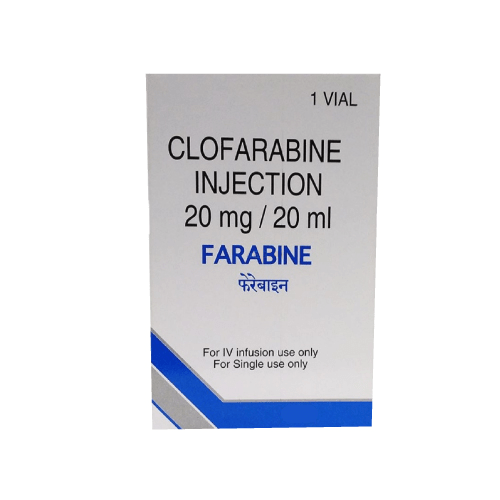Description
Clofarabine 20mg injection is a nucleoside metabolic inhibitor available as a powder for injections generically and under the brand name Farabine. It is approved for use as an antineoplastic agent for the treatment of pediatric patients aged 1 to 21 years with relapsed or refractory acute lymphoblastic leukemia (ALL) after at least a couple of prior regimens.
Dosage and Side Effects of Clofarabine Injection:
The recommended pediatric dose for ALL is 52 mg/m2 administered as an intravenous (IV) infusion over 2 hours once daily for 5 consecutive days of a 28-day cycle, with repeat courses every 2-6 weeks. Provide supportive care, such as anti-hyperuricemic treatment, intravenous (IV) infusion fluids, and alkalinization of urine throughout the 5 days of Clofarabine administration to scale down the probability of tumor lysis and other adverse reactions. Discontinue treatment in case hypotension develops during the five days of administration.
The most common side effects of Clofarabine are headache, vomiting, pain in extremity, nausea, fatigue, diarrhea, abdominal pain, febrile neutropenia, pruritus, bacteremia, pyrexia, rash, tachycardia, anorexia, chills, hypotension, and petechiae.
Warning and Precautions of Clofarabine Injection:
- Treatment with Clofarabine results in myelosuppression which may be serious and prolonged. Myelosuppression is reversible with interruption of Clofarabine treatment and appears to be dose-dependent. Monitor complete blood counts (CBC).
- Critical hemorrhage, including cerebral, gastrointestinal, and pulmonary hemorrhage may occur. The maximum number of cases were associated with thrombocytopenia. Evaluate platelets and coagulation parameters and treat patients accordingly.
- This medicinal product increases the probability of infection, including serious and fatal sepsis, and opportunistic infections. Monitor all the patients for signs and symptoms of infection, stop treatment, and treat them promptly.
- Use of Farabine 20 mg/20 mL may cause tumor lysis syndrome (TLS) linked with the break-down metabolic products from peripheral leukemia cell death. Monitor patients for signs/ symptoms of tumor lysis syndrome (TLS) and start preventive measures including adequate intravenous (IV) fluids and measures to manage uric acid.
- Farabine may be responsible for causing a cytokine release syndrome (tachycardia, tachypnea, hypotension, pulmonary edema) that may progress to the SIRS with capillary leak syndrome and organ impairment which may be fatal. Monitor patients a bit frequently for such conditions.
- Those who have previously received an HSCT are at greater risk for veno-occlusive disease (VOD) of the liver after treatment with clofarabine when used along with etoposide (100 mg/m2 ) and cyclophosphamide (440 mg/m2). Monitor for and discontinue treatment if VOD is suspected.
- Serious and fatal hepatotoxicity, including hepatitis and hepatic failure may occur with the use of this medication. Monitor hepatic function and for signs and symptoms of hepatitis and hepatic failure. Stop treatment quickly for Grade 3 or higher liver enzyme and/or bilirubin elevations.
- Fatal and severe cases of enterocolitis, including cecitis, neutropenic colitis, and C difficile colitis, may occur during treatment with clofarabine 20 mg/20 mL. Enterocolitis may cause perforation, necrosis, hemorrhage, or sepsis complications. Monitor all the patients for signs and symptoms of enterocolitis and treat them quickly.






